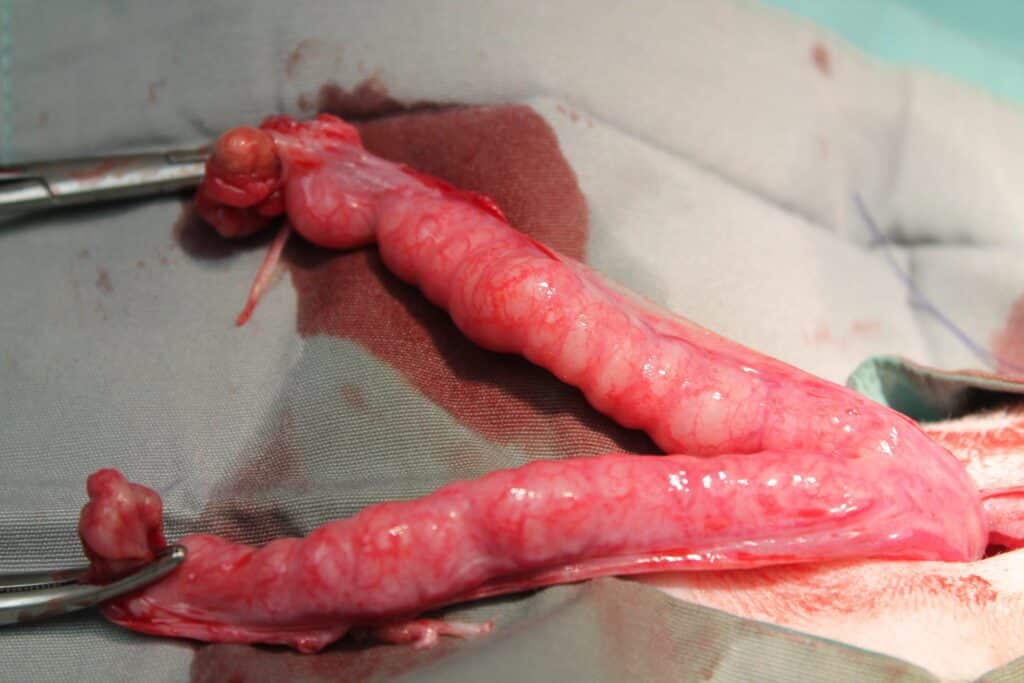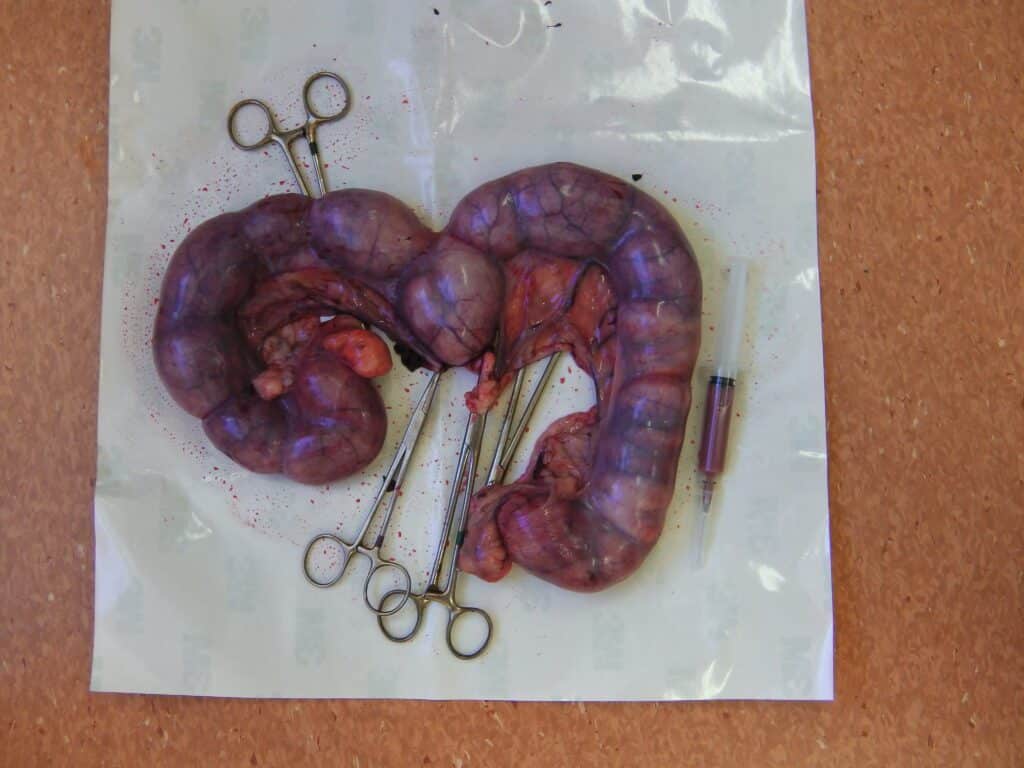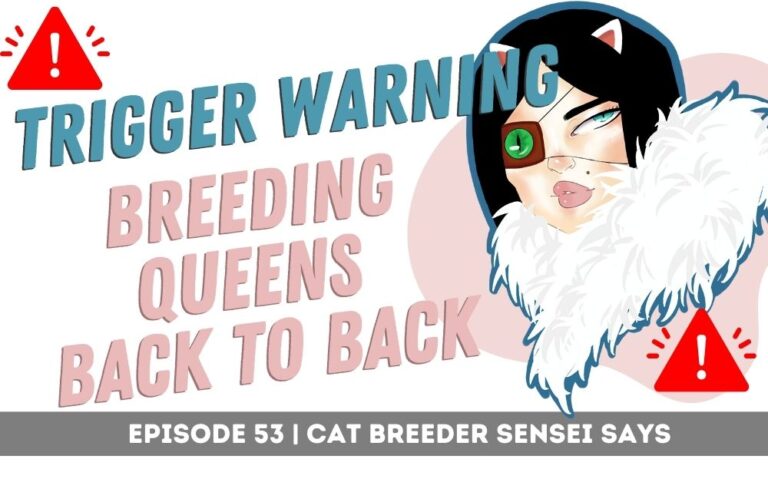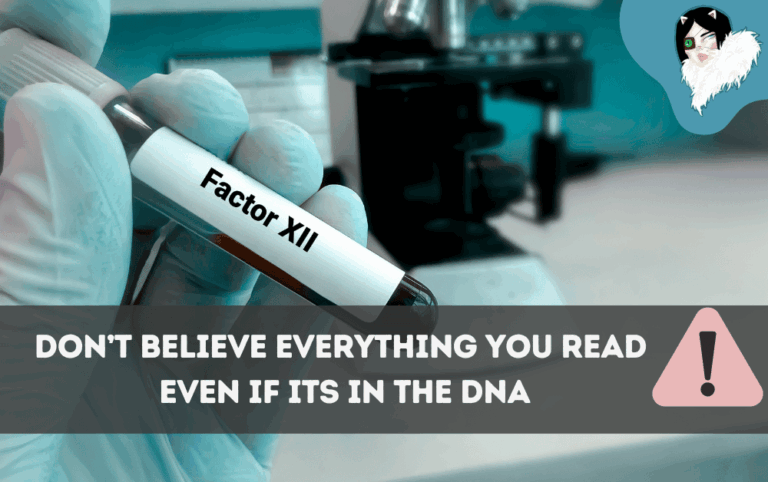Pyometra in Cats: The Mystery of the Uterine Infection
If you’re wondering what pyometra in cats is and how to prevent pyometra in cats, this article should help you. I did this research to publish this information for anyone who may be inquiring about pyometra. I recently had to spay a young 9-month-old (very promising Queen) female due to open pyometra. This was my first experience with pyometra, and it caught me by surprise. I’ve since educated myself heavily on this topic. I’m more familiar now with the causes, the preventions, and the treatment plans for pyometra.
My Maiden girl (Wabi-Sabi) had barely turned the age of 9 months old and had TWO heat cycles when she developed open pyometra. She was taken to the veterinarian on the second day I noticed the vaginal discharge. Unfortunately, the incorrect protocol was suggested by the vet. Instead of the pyometra symptoms improving, they got worse. What started as Green/yellow discharge progressed into yellow infection, bloody discharge, lethargy and fever. This was a major cause for concern. It led me to the ultimate decision to spay her and rehome her as a forever pet.
Hopefully, this information will enable you to learn more about pyometra in the event you find yourself in a situation like this.
In this podcast episode, I reveal the results from a small collection of data that I took from our Facebook Group Members. I wanted to know several factors of which their females had pyometra. Then I organized the results and it’s presented int his podcast. It’s VERY INTERESTING and definitely worth a listen.
What is Pyometra in Cats?
Pyometra is the accumulation of pus within the uterus. This develops because of the hormonal, anatomical, and physiological changes that occur after a cat has gone through a heat cycle but does not become pregnant. Bacteria then take advantage of the situation, resulting in a potentially fatal infection.
During the estrus (heat) cycle, the progesterone level in the female cat increases causing the uterine lining to thicken in readiness for pregnancy. If mating does not occur the uterine lining becomes thickened preventing white blood cells from entering the uterus so that sperm can cause ovulation.
What Causes Pyometra?
Pyometra is caused by the female cat having numerous heat cycles without being mated. Each time the Queen is having an estrus cycle, this risk for pyometra increases. Just how many heat cycles causes this is unknown.
Due to the high level of progesterone in the uterus, the muscles in the wall of the uterus cannot contract easily to expel stored fluid and bacteria. As a result, this fluid becomes a breeding ground for bacteria from the vaginal flora which enters through the cervix (the doorway to the uterus).
What Age Do Cats Get Pyometra?
Pyometra typically occurs in middle-aged to older female cats who haven’t been spayed. The average age is around 4 to 8 years, though it can happen in cats as young as 1 year or as old as 15 years.
Risk increases with age and repeated heat cycles, especially in cats over 5 years old.
Pyometra Symptoms
Pyometra can occur after two to eight weeks of the estrus cycle without pregnancy. But there is a little variation in this number depending on the age of the cat. Most pyometra cases that occur after two to eight weeks of estrus cycle are in a matured cat of ages five and above.
If you notice any of these symptoms in your breeding Queen, take her in to be seen by a veterinarian.
- Vomiting
- Refusal to Eat
- Lethargy
- Increased Thirst
- Excessive Licking of the Vagina
- Yellow and/or Green Vaginal Discharge (Open Pyometra Discharge)
What antibiotics are used to treat pyometra?
There are 2 types of pyometra. Open and Closed. The open form of pyometra is more detectable in your female than closed. The open form of pyometra can be caught early. It can be treated so that she can possibly have a successful mating later. In most cases of closed pyometra, a spay surgery is necessary.
The most efficient method of treating pyometra is by performing Ovariohysterectomy (spaying); This is the surgical removal of the ovaries and uterus of the cat. If the cat that is suffering from pyometra is your breeding Queen, this could inevitably be the end of her career.
The other available method is through antibiotics (Clavamox or baytril) and the administration of Prostaglandins. These are hormones that reduce the progesterone level hence, enabling the contraction of the uterus. The opening of the cervix and allowing the pus and bacteria to flow out of the uterus. The success rate of the Prostaglandins has is not always consistent with success. A strong dose of antibiotics is also necessary to treat pyometra.
WARNING: GRAPHIC


How to Prevent Pyometra in Cats
When your Queen is participating in a breeding program, there is a strange theory that you can avoid pyometra by allowing her to mate on her third or fourth heat cycle. But I’m positive that this isn’t true. especially after the data I collected. (Listen to the podcast for that research).
The most likely cause of pyometra in a young female cat is bacteria. Bacteria such as Strep G and ecoli enter through the cervix during heat cycles and cause infection.Perhaps we can be proactive and implement a more proactive approach to preventing pyometra.
The best way to stay ahead of this is to run a Pre-Breeding PCR on your Queens prior to mating them. This will identify any harmful bacteria that will cause issues with pregnancy and post- delivery. if your PCR shows positive results, then you can treat the Queen before mating her and before she develops infection. This one step alone could prevent any pyometra in your cattery.
Who is Most At Risk for Pyometra?
Typically, older intact female cats are at risk for developing pyometra. This doesn’t eliminate the risk of your female cat having pyometra. As I stated in my opening of this article, my maiden was only 8 months when she developed it. She ended her career as a breeder before it ever began.
I document every estrus cycle with my girls and take precautions to avoid pyometra. In my particular case with Wabi Sabi who developed this ugly infection at such a young age and after only 2 heats, I can say that there’s nothing I could have done differently to prevent this. Maybe she just wasn’t meant to produce kittens in her life. And that’s ok.
Things can happen to cats at any age at any time. It’s up to us to do what’s best for them. We ultimately make the decision for them to be happy and healthy, no matter what. <3
For Additional Information About Pyometra in cats, you can read this article.
Pyometra is usually a concern for breeders. To get more information and learn more about How to become a cat breeder, check out Cat Breeder Sensei.
Learn How to Breed Pedigree Cats
This online course takes you through the entire process of being a Pedigree Cat Breeder.
- Deciding to Join the Cat Fancy
- Cattery Contract Template
- Registering a Cattery
- Rules in your State
- Expenses to Run a Cattery
- Selecting Cats for Your Cattery
- DNA and Genetic Testing
- Designing a Cattery
- Feline Husbandry
- Mating Cats
- Pregnancy in Your Queens
- Labor and Delivery of Kittens
- Raising a Litter of Kittens
- Choosing Buyers for your Kittens
- Kittens Going Home
- And Much More!







We find many cases of this in our TNVR program and some vets recommend euthaniazia.
The numbers of stray cats every where is overwhelming, as well as the suffering they endure. Please help us to stop this overpopulation with our program and others like it. Because of the overpopulation of cats, thousands are killed every month in shelters everywhere. Even adoptable cats have to be destroyed because there are just too many to find good homes.
Hello there! Pedigree cats are not the problem with the overpopulation. The problem there is irresponsible pet owners. We’re in 2 different categories. in 99.9% of cases, you won’t find a Peodgree cat in a shelter. Responsible breeders (which MOST are) find only the best homes for their kittens and offer a promise to take the kitten or cat back at any time, so it doesn’t end up in the shelter. So with all due respect, breeders aren’t the problem – its usually people that cant afford to have a pet in the first place.. Take care.